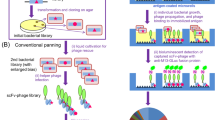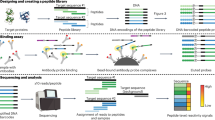Abstract
Phage display selection strategies rely on the physical link between the displayed heterologous protein ligand and the DNA encoding it. Thus, genes expressing a ligand with a specific binding affinity can be selected rapidly. To improve the specificity and sensitivity of this technology for potential use in identifying ligands to a specific antibody present in a complex mixture, we incorporated a DNA selection step along with the phage display technology. Ligands for hepatitis C virus (HCV) antibodies present in serum were identified by panning a phage-displayed random peptide library against pools of serum HCV antibodies. An additional DNA hybridization screening step using single-stranded DNA isolated from one of the pools increased the specificity and sensitivity, resulting in the selection of an HCV antibody ligand with diagnostic potential.
This is a preview of subscription content, access via your institution
Access options
Subscribe to this journal
Receive 12 print issues and online access
$209.00 per year
only $17.42 per issue
Buy this article
- Purchase on Springer Link
- Instant access to full article PDF
Prices may be subject to local taxes which are calculated during checkout




Similar content being viewed by others
References
Smith, G.P. and Petrenko, V.A. 1997. Phage display. Chem. Rev. 97: 391– 410.
Folgori, A., Tafi, R., Meola, A., Felici, F., Galfrè, G., Cortese, R. et al. 1994. A general strategy to identify mimotopes of pathological antigens using only random peptide libraries and human sera. EMBO J. 13: 2236–2243.
Prezzi, C., Nuzzo, M., Meola, A., Delmastro, P., Galfre', G., Cortese, R. et al. 1996. Selection of antigenic and immunogenic mimics of hepatitis C virus using sera from patients. J. Immunol. 156: 4504–4513.
Mennuni, C., Santini, C., Lazzaro, D., Dotta, F., Farilla, L., Fierabracci, A. et al. 1997. Identification of a novel type 1 diabetes-specific epitope by screening phage libraries with sera from pre-diabetic patients. Mol. Biol. 268: 599–606.
Barry, M.A., Dower, W.J., and Johnston, S.A. 1996. Toward cell-targeting gene therapy vectors: selection of cell-binding peptides from random peptide-presenting phage libraries. Nat. Med. 3: 299– 305.
Pasqualini, R. and Ruoshlahti, E. 1996. Organ targeting in vivo using phage display peptide libraries. Nature 380: 364–366.
Alter, H.J. 1995. To C or not to C: these are the questions. Blood. 85: 1681.
Birch, D.E., Kolmodin, L., Laird, W.J., McKinney, J., Wong, J., Young, K.K.Y. et al. 1996. Simplified hot start PCR. Nature 381: 445–446.
Livak, K.J., Flood, S.J.A., Marmaro, J., Giusti, W., and Deetz, K. 1995. Oligonucleotides with fluorescent dyes at opposite ends provide a quenched probe system useful for detecting PCR product and nucleic acid hybridization. PCR Methods Appl. 4: 357–362.
Tyagi, S. and Kramer, F.R. 1996. Molecular beacons: probes that fluoresce upon hybridization. Nat. Biotechnol . 14: 303–308.
Tanaka, E., Kiyosawa, K., Nakatsuji, Y., Inoue, Y., Miyamura, T., Chiba, J. et al. 1993. Clinical significance of antibodies to nonstructural and core proteins of hepatitis C virus in postransfusion hepatitis patients during long-term follow-up. J. Med. Virol. 39: 318–324.
Khudyakov, Y.E., Khudyakova, N.S., Jue, D.L., Lambert, S.B., Fang, S. and Fields, H.A. 1995. Linear B-cell epitopes of the NS3-NS4-NS5 proteins of the hepatitis C virus as modeled with synthetic peptides. Virology 206: 666–672.
Felici, F., Castagnoli, L., Musacchio, A., Jappelli, R., and Cesareni, G. 1991. Selection of antibodies ligands from a large library of oligopeptides expressed on a multivalent exposition vector. J. Mol. Biol. 222: 301–310.
Luzzago, A., Felici, F., Tramontano, A., Pessi, A., and Cortese, R. 1993. Mimicking of discontinuous epitopes by phage displayed peptides, I. Epitope mapping of human H ferritin using a phage library of constrained peptides. Gene 128: 51–57.
Dente, L., Cesareni, G., Micheli, G., Felici, F., Folgori, A., Luzzago, A. et al. 1994. Monoclonal antibodies that recognise filamentous phage. Useful tools for phage display technology. Gene 148: 7–13.
Sambrook, J., Fritsch, T., and Maniatis, T. 1989. Molecular cloning: a laboratory manual 2nd ed. Cold Spring Laboratory Press, Cold Spring, NY.
Spratt, B.G., Hedge, P.J., Heesen S., Edelman A., and Broome-Smith, J. 1986. Kanamycin-resistant vectors that are analogues of plasmids pUC8, pUC9, pEMBL8, and pEMBL9. Gene 41: 337–342.
Bartoli, F., Nuzzo, M., Pezzanera, M., Nicosia, A., and Monaci, P. 1996. Rapid protocol for template preparation of large numbers of clones. Biotechniques 20: 554–558.
Takamizawa, A., Mori, C., Fuke, I., Manabe, S., Murakami, S., Fujita, J. et al. 1991. Structure and organisation of the Hepatitis C virus genome isolated from human carriers. J. Virol. 65: 1105– 1113.
Smith, D.B. 1993. Purification of glutathione S-transferase fusion proteins. Methods in Molecular and Cellular Biology. 4: 220–229.
Frangioni, J.V. and Neel, B.J. 1993. Solubilization and purification of enzymatically active glutathione S–transferase (pGex) fusion proteins. Analyt. Biochem. 210: 179–187.
Acknowledgements
We wish to thank Frank Graham and our colleagues at IRBM for reading the manuscript, making comments, suggestions, and criticisms, and J. Clench for the linguistic revision of the text.
Author information
Authors and Affiliations
Additional information
Istituto di Ricerche di Biologia Molecolare P. Angeletti Via Pontina km 30.600 00040 Pomezia (Roma), Italy.
Rights and permissions
About this article
Cite this article
Bartoli, F., Nuzzo, M., Urbanelli, L. et al. DNA-based selection and screening of peptide ligands. Nat Biotechnol 16, 1068–1073 (1998). https://doi.org/10.1038/3525
Received:
Accepted:
Issue Date:
DOI: https://doi.org/10.1038/3525
This article is cited by
-
Antigen-Specific IgG Antibodies in Stage IV Long-Time Survival Breast Cancer Patients
Molecular Medicine (2001)



